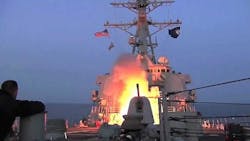Raytheon to upgrade venerable Tomahawk cruise missile for anti-ship role against moving enemy vessels
Officials of the U.S. Naval Air Systems Command at Patuxent River Naval Air Station, Md., announced a $119 million order last week to the Raytheon Missile Systems segment in Tucson, Ariz., to integrate seeker suite technology and processing capabilities into the Tactical Tomahawk Block IV missile in support of the Maritime Strike Tomahawk Program.
The order provides for analysis, trade studies, architecture, modeling, simulation development, evaluation, and prototyping activities for an anti-ship missile version of the Tomahawk, which will be called the Maritime Strike Tomahawk variant.
Raytheon and Navy experts are determining the most appropriate type of sensor for the Maritime Strike Tomahawk. It could be a multi-mode seeker with a mix of passive and active sensors.
Related: Raytheon to replace obsolescent I/O circuit cards in Tomahawk missile communications system
“We’re upgrading the radio, the harnessing and the antenna for the communication. So every recertified missile will get an upgraded navigation and communication,” Capt. Mark Johnson, Naval Air Systems Command PMA-280 program manager, told USNI News last month.
The upgrade of Tomahawk land-attack missiles to maritime strike variants also will involve warhead enhancements, as well as technology to enable the new missiles to operate in areas where GPS satellite navigation signals are jammed or otherwise inoperative. The first of the Maritime Attack Tomahawk missiles should be ready by the early 2020s.
The Tomahawk Block IV missile first was introduced in 2006. It adds a strike controller that can change the missile in flight to one of 15 preprogrammed alternate targets or redirect it to a new target. This missile can loiter over the battlefield waiting for target opportunities.
The Block IV can transmit battle damage imagery and missile health and status messages via the two-way satellite data link. It also has an anti-jam GPS receiver.
Related: Navy updates Tomahawk cruise missile control system processors and software
The Tomahawk carries a 1,000-pound high-explosive warhead or submunitions dispenser. The subsonic missile can fly more than 1,000 miles at 550 miles per hour at 98 to 160 feet above the ground or water.
Surface warships and submarines can launch the Tomahawk from the vertical launch system or from horizontal torpedo tubes. A supersonic version of the Tomahawk with a ramjet to increase its speed to Mach 3 is under consideration.
On this order Raytheon will do the work in Tucson, Ariz.; Dallas; Boulder, Colo.; and at other locations, and should be finished by August 2019. For more information contact Raytheon Missile Systems online at www.raytheon.com, or Naval Air Systems Command at www.navair.navy.mil.
Learn more: search the Aerospace & Defense Buyer's Guide for companies, new products, press releases, and videos
